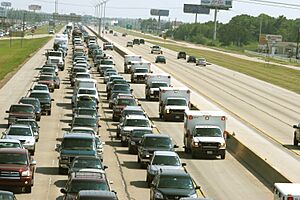Emergency evacuation facts for kids
Emergency evacuation is when people quickly leave an area because there's a danger. This danger could be something happening right now, something about to happen, or something that could harm lives or property.
Imagine a small evacuation, like leaving a building because of a storm or fire. Or a big one, like a whole city moving away from a flood or a big hurricane. If there are dangerous chemicals or pollution, people might need to be cleaned before they can leave the area completely. Planning for these evacuations is a big part of keeping people safe.
Why do people evacuate?
People might need to evacuate before, during, or after different kinds of disasters. Here are some reasons:
- Natural Disasters
- Volcano eruptions
- Tropical cyclones (like hurricanes or typhoons)
- Floods
- Earthquakes
- Tsunamis (giant ocean waves)
- Wildfires or bushfires
- Industrial Accidents
- Chemical spills
- Nuclear accidents
- Transport Accidents
- Car accidents
- Train wrecks
- Plane emergencies
- Fires
- Fires in buildings or factories
- Military or Terrorist Attacks
- Bombings
- Terrorist attacks
- Military battles
- The threat of nuclear war
- Building Problems
- When a building might fall down
- Health Risks
- A fast-spreading viral outbreak
- Crime
- A robbery
Planning for safety
Emergency evacuation plans are made to help everyone leave a building, city, or region as safely and quickly as possible. Experts figure out how long it should take to evacuate for different dangers. They might use computer models to see how people move through a building.
Good planning uses many exits and special traffic lanes (like turning all lanes in one direction) to help people get out fast. Planners also think about people who might need extra help, like those with disabilities. This includes using alarms that make sounds and show lights, and having special equipment like sleds or chairs for people who can't walk easily. It's very important that everyone, including people with disabilities, can get to a safe place.
Building rules also help make sure people can leave safely without causing panic. Good plans cover all kinds of dangers, so they can be used for many different situations.
Key parts of emergency planning include:
- Giving early warnings to people.
- Having clear exit routes and ways to leave a building safely and quickly.
- Making sure the team managing the evacuation knows exactly what to do.
How an evacuation happens
An evacuation usually follows these steps:
- Detection: Someone notices a danger.
- Decision: A choice is made to evacuate.
- Alarm: People are warned to leave.
- Reaction: People start to move.
- Movement: People go to a safe area or a meeting spot.
- Transportation: People are moved away from the danger zone.
The first four steps (detection, decision, alarm, reaction) are often called the "pre-movement time."
For places like ships, there are extra steps. People first gather at an assembly point. Then, a separate decision is made about whether to get into lifeboats or rafts.
See also
In Spanish: Evacuación para niños



